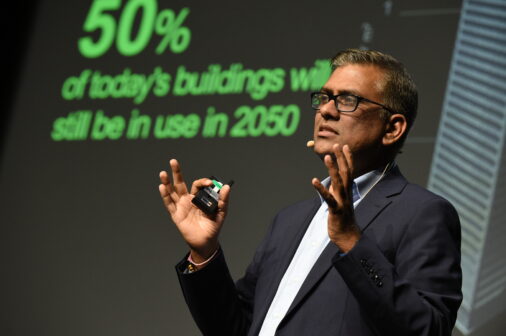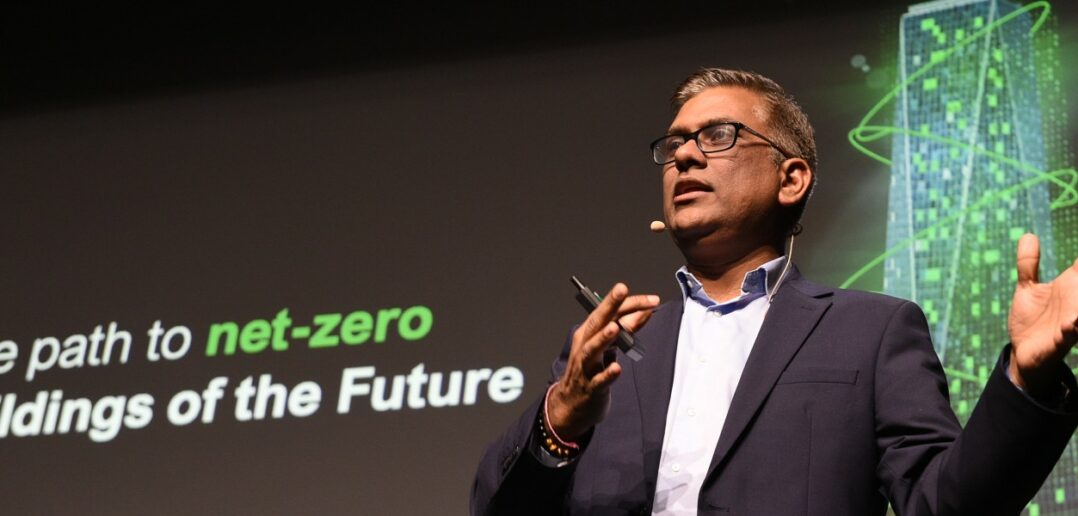According to Manish Kumar, Executive Vice President of Digital Energy at Schneider Electric, “Commercial real estate (CRE) accounts for 37% of all CO2 emissions.” Although CRE remains the world’s largest asset class, for decades it has lagged other sectors like Finance and Technology in terms of decarbonizing its footprint and faces becoming a stranded asset.
Reality Starts to Set In
“Thirty percent of all emissions released from CRE comes just from the design phase” notes Manish Kumar. Once buildings are designed and plans are submitted to build, there is very little developers and property owners can do to decrease their building’s carbon footprint outside of very drastic and capital-intensive redevelopment. Additionally, during manufacturing and construction, enormous amounts of Scope 1 and 2 emissions are released. This is why it is so important for the commercial building industry to use sustainable techniques and materials in their design and construction phases.

Improved Technology is Widely Available
Improved technology can be employed to boost operational and energy efficiency. Businesses can reduce their carbon footprint and help make the world a healthier place by using energy-efficient technologies like energy star rated HVAC (Heating, Ventilating and Air Conditioning) systems with Merv filters, renewable energy sources like solar and wind, and sustainable building materials like mass timber and bendable concrete. Sustainable features that can be added to building and maintenance plans include green roofs and smart lighting systems to name a few. Additionally, this is a great time to take advantage of the fact that older properties can be modified to use less energy with widely available options like electric heat pumps, unlike traditional heat pumps that use natural gas.
Commercial building owners can not only contribute to a healthier environment by investing in sustainable practices, but they can also save money in the long run with lower energy expenses, while increasing their property’s value and decreasing risk. Many owners are unclear where or how to begin their decarbonization journey because each property and portfolio is so unique. Kumar highlights three main areas where we have an opportunity to make the most impact: strategizing, digitizing, and decarbonizing.
Charting a Course for Success: Developing a strategy
For CRE owners, the path to reaching net zero can be daunting. Owners often ask themselves a few questions. Where do we start? What actions do we choose to act on? How do we go from vision to action?
In order to answer these questions owners must completely reevaluate how they consume energy, how their supply chain works, what products they sell, and how they interact with customers. When developing a strategy, it is helpful to follow a couple rules. These rules include setting goals, communicating commitment to stakeholders, making energy use more efficient, and evaluating and reporting progress on a regular basis. If companies can begin with this short set of rules to abide by, they can begin to not only lessen their impact on the environment, but increase their competitive edge through leaner corporate strategy.
Making buildings more energy efficient is the most direct path to managing the climate crisis, managing demand, and managing prices.
Unlocking the Power of Digitization
By providing more accurate data and allowing businesses to make better decisions, digitization can help commercial real estate deal with climate change. Data analytics and reporting systems can be used to collect and analyze data on energy use, transportation, trash, and other factors that cause emissions. This lets owners and managers of commercial real estate better track and report their greenhouse gas emissions, which is needed in order to meet goals and keep track of progress. 3D modeling and simulation technologies like Clash Detection, which is widely available, can be used to improve and test building designs. Virtual reality and AI can be used to visualize and test design ideas, without emitting any CO2.
Harnessing Electricity for New Infrastructure
The last area that can make the greatest impact for CRE owners is electrification. Already today, many cars and homes are using electricity to improve efficiency. It is time for CRE to start to harness the power of electricity and begin upgrading the electrical infrastructure. Whether it be thorough solar microgrids or even hydroelectric power, CRE buildings need to begin to replace their supply with greener resources that are currently widely available for use. With the combination of digitization and electrification, CRE owners have a massive opportunity to drive towards net zero and usher in the new “Electricity 4.0” generation as Kumar calls it.
A Resilient Future
Reaching net-zero for commercial real estate is essential for mitigating the impacts of climate change and ensuring a sustainable future for generations to come. Commercial buildings account for a significant portion of global carbon emissions and reducing these emissions through net-zero strategies such as energy efficiency, renewable energy sources, and carbon offsets can help to minimize their environmental impact. As the world continues to grapple with the challenges of climate change, the adoption of net-zero strategies in commercial real estate is a crucial step in the right direction towards a more sustainable and resilient future.
Article written by Seth Gergel and Jessie Kelley who have master’s degree in real estate from the University of San Diego.



